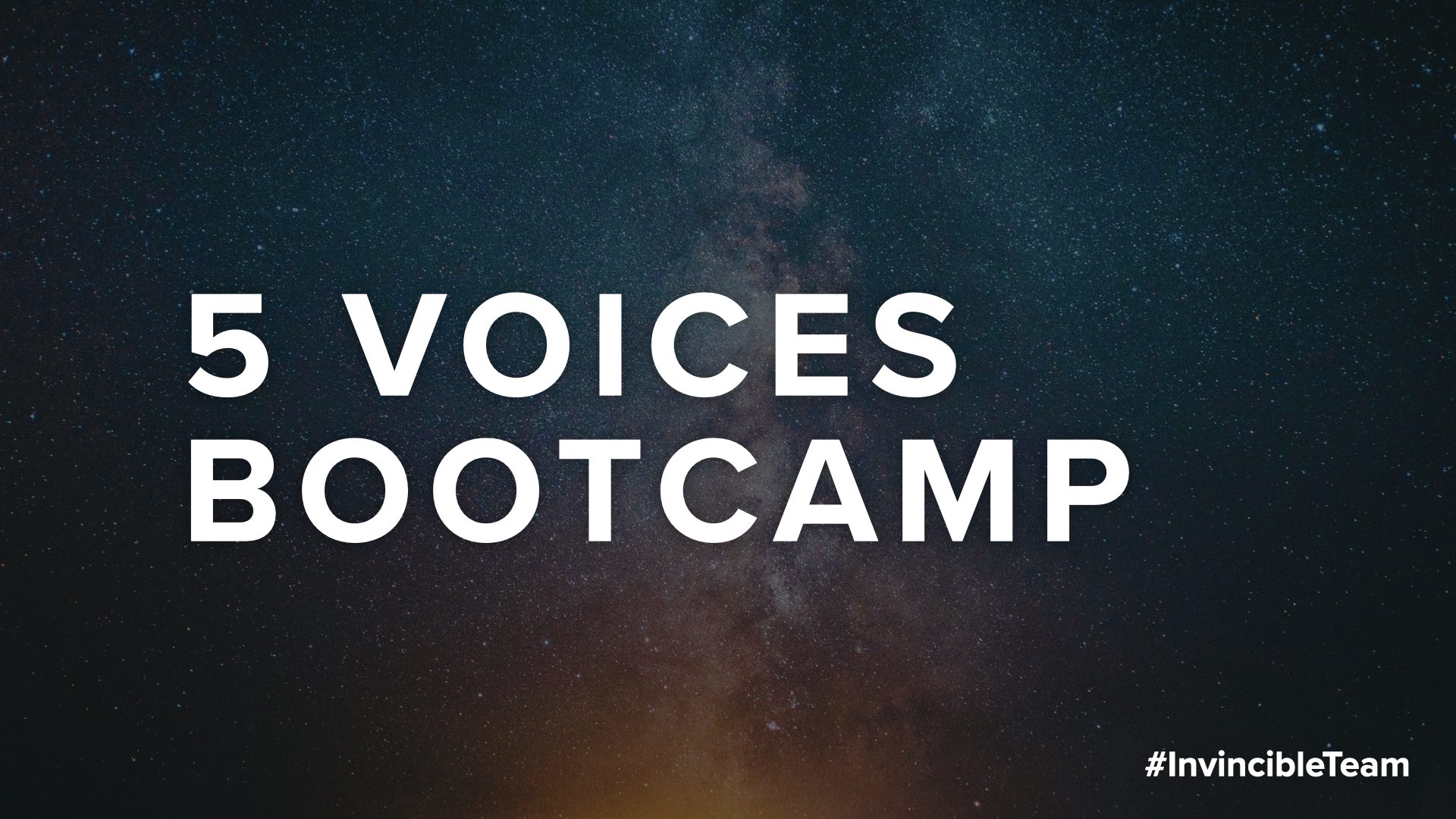How do I get the most out of the people on my team?
How do we win our market?
Is turnover a problem for other organizations?
How can we achieve goals on time and on budget?
Most teams score less than 60% on a team performance assessment.
Better Leaders. Healthier Culture. Improved Performance.
It all begins with the building blocks of High Performing Teams. Build a foundation on clear communication and objective language, and you will start increasing your team’s performance.
The 5 Voices is our language of Communication, and it helps teams begin to understand each team member, beginning with our own conflict, processing, and stress management.
Thanks for joining today’s demo of the 5 Voices Bootcamp! Jumpstart your own Bootcamp by identifying your Voice.
Welcome to the 5 Voices Bootcamp!
I am excited to welcome you into a demo of an exciting new workshop that we are offering teams, as we introduce what the 5 Voices can mean to your team, to your organization, and improving your people strategy.
Here is our team performance score or metric, and this tool helps us understand the building blocks of high-performing teams. Communication is where we start in the Bootcamp.
But if you look at the bottom execution and alignment, or in order alignment and execution, this tool builds in a clockwise motion from communication to relationships, alignment, execution, and capacity. Most teams with laughable predictability run into a problem, and they immediately jump to alignment.
- Who can we move in or out of this team?
- How can we merge these teams? Separate teams?
- Can we create something organizationally or structurally, and then move into execution?
Back and forth they go, between alignment, execution, alignment, execution. No matter what the problem is, no matter what’s going on, teams move back and forth with laughable predictability across industries, across the globe, any kind of organization.
That’s how we tend to respond, but communication is the true foundational building block. And if you don’t have clear, common language as a foundation on which you can build healthy relationships, you’re not going to get anywhere. So that’s where we go with this tool is in getting to communication.
What are the 5 Voices?
Our communication tool is the 5 Voices. And this is an actual team that we led a Bootcamp with a few weeks ago as an introduction, a way for them to get to know the tool and begin to benefit their team.
Here are the 5 Voices. You see icons at the top, the five names, there’s a volume meter, which talks about the forcefulness and persuasion in our communication. We know from research and data, how much of the population is made up of each voice. And then at the bottom, you see team members representing how the team shook out, in this particular team.
Nurturers

So the Nurturers are quiet. They’re reserved. They’re very people-focused, very keen on relational harmony and making sure values are kept in alignment. They will care. They will celebrate. They will recognize the other people on the team, but in their forcefulness or lack thereof, they’re not very persuasive communication. They don’t want to disrupt the relationship.
They’re very present-oriented people here and now today in front of them and who they are around on an everyday basis, 43% of the population, are Nurturers, which should make all of us feel pretty good that there are that many nurturing, caring, people-oriented people around us.
Creatives

Now, Creatives – a little bit more forceful, but not that much – only make up 9% of the population. And these are the most future-oriented voices out there. They’re thinking about future ideas, scanning the horizon. What are the possibilities?
What could be? What could be going on right here in the coming weeks, months, years? They’re going to see future ideas and want to innovate, and also have this sense of organizational integrity, social conscience.
If there is a value that the organization claims to hold that is being trampled on the Creatives are going to become the most vocal about this.
Creatives want to envision the future.
They want to see what’s out there with a perfectionist tendency. Their drive is towards perfection, trying to get their idea – what they are seeing out in the horizon – to become this powerful reality in the present.
Creatives constantly drive to that level of perfection, of what they envision in their minds now.
Guardians
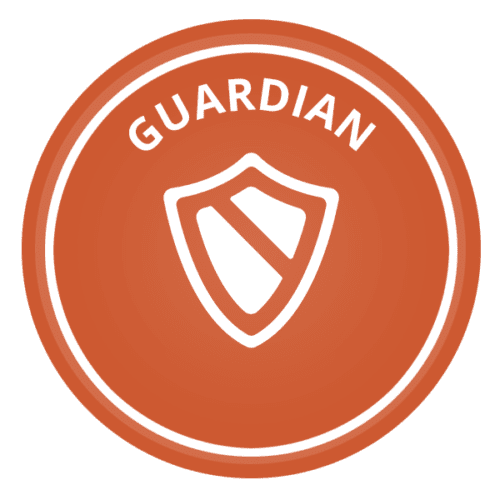
Ever so slightly more persuasive, more forceful are the Guardians. The Guardians have this shield of right truth process.
They do their due diligence. They have deadlines, they have goals. They have expectations.
They know what to expect, and they will ensure that the team and the organization stick to that. 30% of the population are Guardians, another present-oriented voice, and together with the Nurturers, Guardians and Nurturers make up nearly 75% of the population.
That’s our present-oriented voices, focused on here and today, not as keen on future and vision and goals. But they can get there.
Connectors
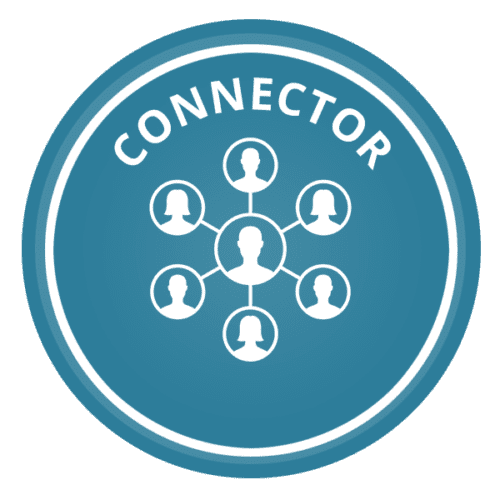
The Connectors are also like Nurturers, very people oriented, but people in terms of possibilities, what connections can we make? What can we orchestrate in our relational networks? The passions that people have, how can we awake in awaken in them that collaborative possibility and bring people together to ignite their shared passion. And the Connector will maintain a Rolodex in their mind, not of just names and contacts,
But how did I get to know you? In what context did I get to know you? How can we file away some information on what you’re passionate about? What’s your drive is.
They’re very effective communicators. They are really good at seeing the future, the possibilities, and being able to communicate that.
Now 11% of the population are Connectors, future-oriented together with the Pioneers and Creatives.
Pioneers

Pioneers are those future-oriented voices that only make up 7% of the population.
Pioneers are future-oriented like Creatives, but they see the peak of a mountain and they want to blaze the trail, align the resources to get there as efficiently as possible.
They can put all the pieces together into a plan, see that vision, wanting to win, and accomplish the goal. Stake that flag on top of the mountain peak and win. Very future-oriented very driven.
And you see this volume and persuasiveness can almost stretch, push the limits too far. If you think of an old stereo system where the sound got a little scratchy, once it got up into the red, that can be a pioneer sometimes. So driven, so forceful, so persuasive that sometimes it can be overwhelming.
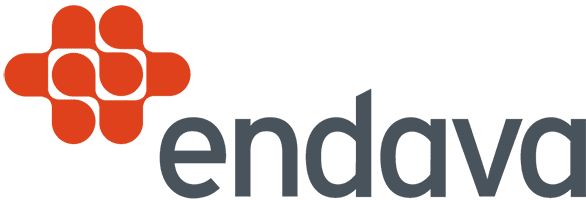
“5 Voices is in everyday use inside our organization. The powerful vocabulary helps our people to communicate and lead more effectively and to fulfill our passion for enabling our people to be the best that they can be.”
JOHN COTTRELL, CEO ENDAVA
5 Voices Team Dynamics
Well, let’s put these 5 Voices in a different visual.
At the top, you have people who make decisions based on people and values, at the bottom systems and logic. On the left, we have the present-oriented voices in the here and the today. On the right are future-oriented voices, thinking and dreaming, conceptualizing conceiving ideas about the future.
Now you see in the middle, there are dotted lines that criss-cross. And so as you look from the bottom left this criss-cross line to the top, right, or from the top left to the bottom, right? Anytime you have these opposite quadrants, that’s ripe for conflict.
It’s also ripe for the potential of collaboration and where we can most benefit from tapping into another voice.
The way I like to describe this for a team is optimally, you have all of the voices represented. Imagine there’s an issue sitting right there in the crosshairs, in the middle of those two axes. As you look at the issue, you are getting a good well-rounded perspective of what could be, what we need to tackle, what we need to be mindful of, how we can make this plan, come to life, come to fruition.
But we can’t do that when there’s constant conflict within the team. When there are disagreements, based on what you see here are differences in perspectives.
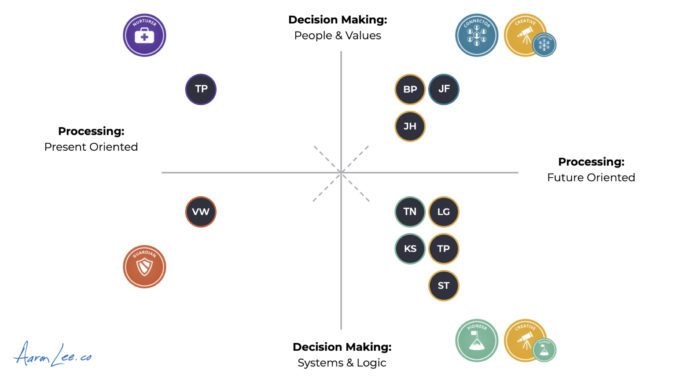
I’ll tell you an example. You see VW down here in the Guardian quadrant (bottom left) and we’ll use JF in the top, right quadrant. With a different client, different organization, we had this conversation about these two individuals. Both are department managers who had a conflict with each other. The Connector is a little more forceful than the Guardian, but the Guardian has that rightness and that truth, the process, what the expectations are supposed to be.
And the challenge for those two in that relationship was the Connector said, “Hey, people first, I don’t want to disrupt the relationship. So I will just defer to the other person.”
They were having conflict, and in their communication, they were just missing each other with this framework. They now had an ability to see, “Oh, we’re looking at things from completely opposite worldview perspectives.” I’m processing information very differently than that. And you, it took it from being anger and relationally-driven, there is a problem here, to having common language and understanding.
Remember, the foundational building block of team performance is clear communication.
They now had a way to describe what was going on in objective language, not subjective feelings, thoughts, and emotions that were brought into the relationship. With that objective understanding, they were able to clarify and see the potential of why they needed to tap into and lean on each other.
I’ve seen time and time again, Nurturers and Pioneers, who will naturally see some disconnect in how they see the world. They’ll often struggle. Nurturers, especially because Pioneers will just drive, drive, drive, but there will be a disconnect.
The Nurturers will wonder,
“Why is the Pioneer being so driven and forceful?”
And it’s exemplified by being in opposite quadrants. This nemesis view illuminates potential for conflict, but it also illuminates the greatest potential for collaboration and working together. So this is the tool that lays the groundwork for maximizing team performance.
Most teams function at less than 60% of their true potential.
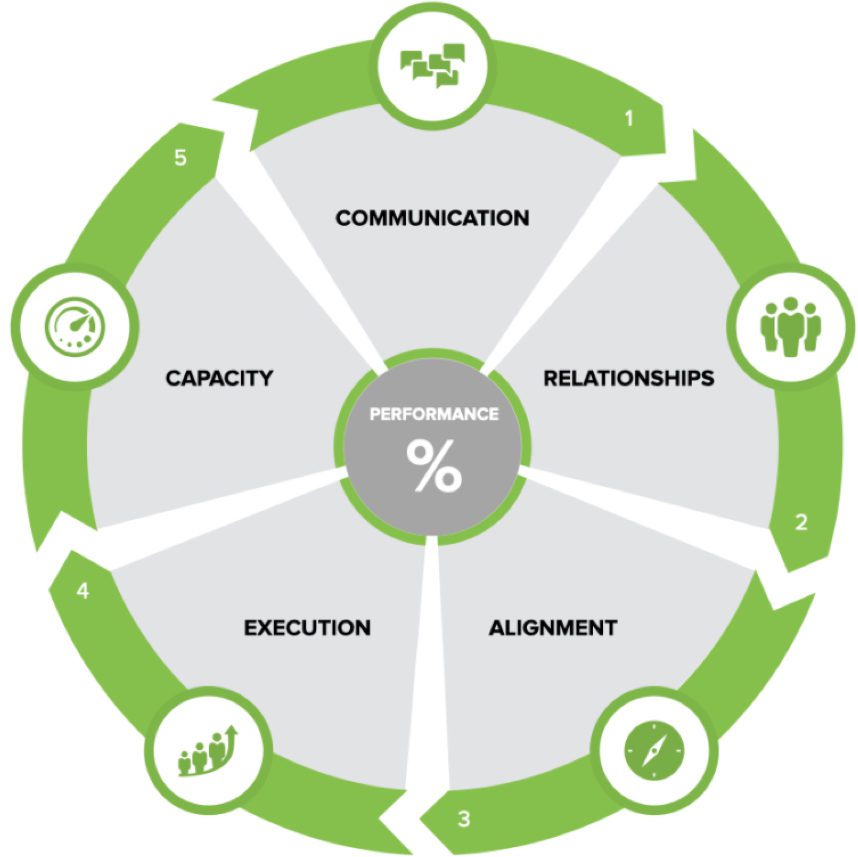
© Pub House
When we measure a team based on these five metrics, most teams across the globe, across industries, across the size of the business, a team functions at less than 60% of their true potential.
If we can focus on these building blocks – if we can establish clear communication, healthy relationships, build alignment, begin to execute – we can get to a place of increasing capacity and reaching the next level with our team performance that has a significant cost effect for a team.
We can increase that score. We can have some positive effects.
Assess > Toolkit > Process
We begin with the assessment of the 5 Voices, getting to know ourselves and who’s on the team.
Then we assess the team. We benchmark the reality of what you’re sensing, what you’re experiencing with data. We identify specific growth opportunities, demonstrating progress. As we measure this quarter by quarter, and we’re being intentionally effective.
| INADEQUATE ORGANIZATION | INVINCIBLE ORGANIZATION |
| Doesn’t Benchmark Reality With Data | Benchmarks Reality With Data |
| Doesn’t Know Where To Focus | Identifies Growth Opportunities |
| Can’t Demonstrate Progress | Can Easily Demonstrate Progress |
| Accidentally Effective | Intentionall Effective |
We’re not just throwing things at the wall to see what sticks. We’re working hard based on data of our team performance, to increase our team’s performance, expectations, output profits, goals, all of those ingredients of high performing teams. We do that through our virtual platform.
If you’re interested in holding a Bootcamp with your team and kickstarting this process with us, just go to AaronLee.Co/5voices.

You can take the 5 Voices assessment right now. Begin to understand your own voice, see how that might fit into understanding how your team functions, how your team operates, starting with how you function, how you communicate, how you handle conflict, how stress affects you. All of those pieces go into how and why we experience things in our team.
I hope this tool of the 5 Voices will go a long way to helping you jumpstart your team’s performance.
